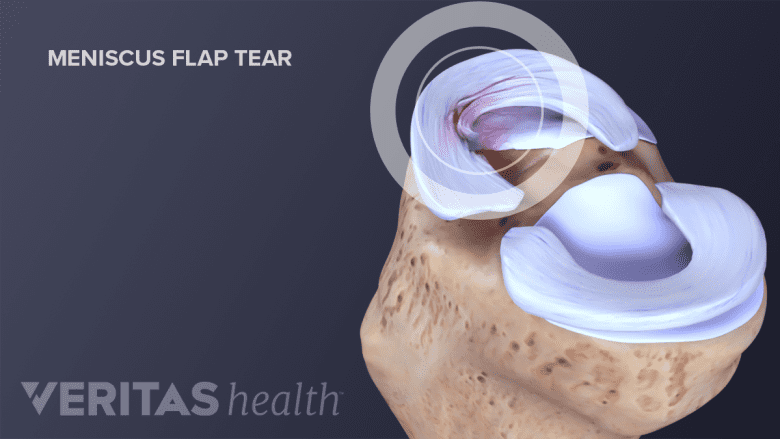Injury to the bones of the knee joint can cause moderate to extreme pain, depending on the severity of the bruise or fracture. Considering how integral the knee joint is to movement, injury to these bones may also cause reduced mobility during the healing process. Injuries to the leg bones are most common in contact sports such as football, hockey, or lacrosse.
In This Article:
- Guide to Knee Joint Anatomy
- Soft Tissue of the Knee Joint
- How Knee Joint Problems Cause Pain
Common Sports Injuries of the Knee Joint
Some of the most common athletic injuries to the knee joint include:
Torn Meniscus

Meniscal tears occur due to sudden twisting or traumatic impact on the knee joint.
Either of the menisci in either knee can be torn as a result of an aggressive twisting motion, or traumatic contact with the knee. Torn menisci are among the most common athletic injuries pertaining to the knee. The meniscus can also degenerate over time as a person ages. A person with a torn meniscus may feel knee pain during rest and knee pain that worsens with deep squatting or going down stairs.
ACL Tear
A torn anterior cruciate ligament often results from a one-time trauma, such as sudden twisting or an impact to the knee. Individuals who suffer an ACL tear will likely be unable to continue competition. They will also likely require an orthopedic consultation.
See Anterior Cruciate Ligament (ACL) Tears
Prepatellar bursitis

Prepatellar bursitis results from repetitive pressure, like frequent kneeling or bending of knee joints.
The most common form of knee bursitis, prepatellar bursitis is the inflammation of a bursa at the front of the knee. This is also known as nursemaid’s knee. Pre-patellar bursitis results from inflammation and swelling. Knee bursitis often develops from repetitive motion or pressure on the knee, such as frequent kneeling on or bending of the joint. Pain from a case of knee bursitis will typically lessen with rest but return with activity. Bursitis can also be caused by bacterial infection.
Tendonitis and tendinopathy
This can affect any tendon in the knee but the most common is the patellar tendon and the quadriceps tendon. Recent research has shown that tendinopathy does not involve inflammatory cells. Therefore, a better way to think of tendinopathy is degeneration of the tendon. Degeneration of a tendon can affect knee strength and mobility as well as cause pain.
See Chronic High (Proximal) Hamstring Tendinopathy
Distal Iliotibial band syndrome
The iliotibial band, more commonly known as the IT band, originates at the outside of the hip, crosses the knee and inserts on the outside of the shin bone. People with IT band friction syndrome typically experience sharp pain at the outside of the knee joint, particularly when the foot hits the ground.
See IT Band Syndrome Causes and Risk Factors
Patellofemoral syndrome
This condition occurs when the patella (kneecap) does not track correctly within the patellofemoral groove. Patellofemoral syndrome most commonly results from congenital alignment or hip abductor weakness. Pain from patellar malalignment will be present during athletic activity and particularly exercise that result in repetitive bending of the knee or running activities.
See What You Need to Know About Runner’s Knee
Other Conditions of the Knee Joint
Injuries to the knee can also occur as a result of aging and normal degradation of the body. Common causes of knee joint pain that result from causes besides athletic injury are:
- Gout. This condition arises from high uric acid levels within the body and results in inflammation and deposition of uric acid crystals within the synovium (joint capsule). This results in knee stiffness and pain within the knee joint. Gout pain typically comes on quickly, and can become severe in a matter of hours.
- Pseudogout. Similarly to gout, pseudogout causes sudden and severe inflammation and pain in the affected joint. Pseudogout results in calcium pyrophosphate deposition within the synovium (joint capsule).
- Osteoarthritis. This is the most common diagnosis in all of medicine. This form of arthritis is very common, and occurs when the hyaline articular cartilage wears away from the ends of a bone. Without the cushioning provided by that cartilage, the bones of the knee joint can rub together during motion and cause pain within the joint.
While most acute knee injuries are immediately apparent, other injuries and painful knee conditions develop gradually over time, and an individual may not notice the problem until the joint damage produces knee pain.

